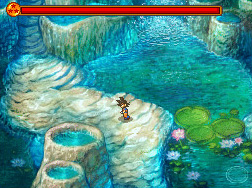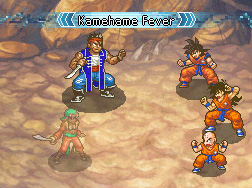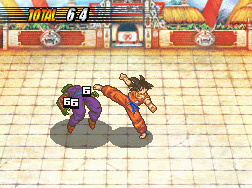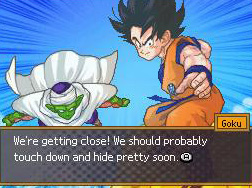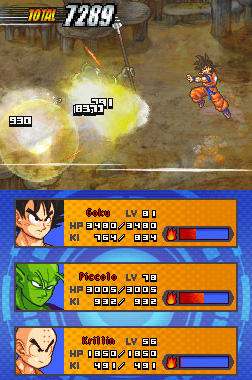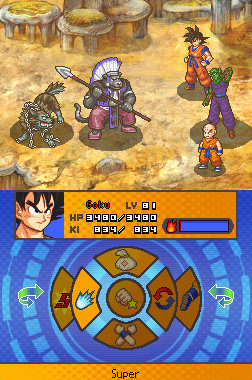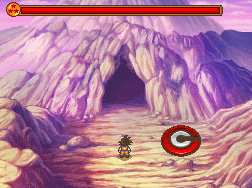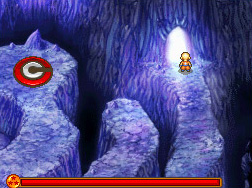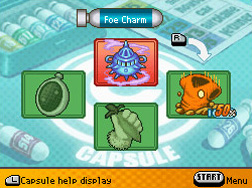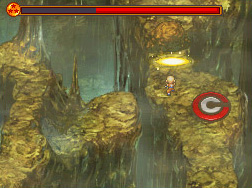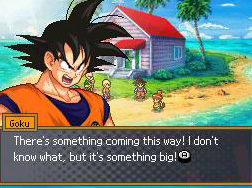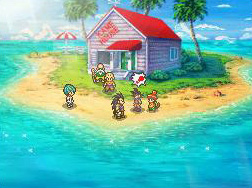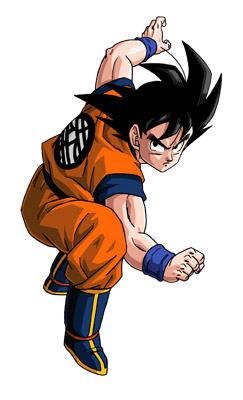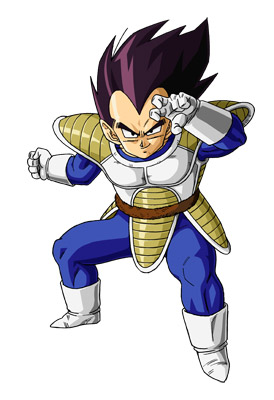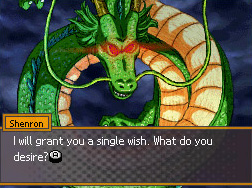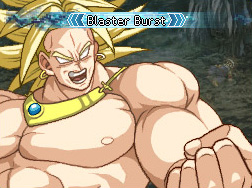Back in mid-December 2008, a new game called Dragon Ball Z Story: Saiya-jin Raishū (Saiyan Invasion) was announced for the Nintendo DS. It was set to be a role-playing game featuring teams of three (with six characters available for play), and would run from the 23rd Tenka’ichi Budōkai up through the Saiyan arc of the series. The game was set to be published by Namco-Bandai in Japan in Spring 2009.
In the meantime, a newly “refreshed” version of the Dragon Ball Z TV series was announced for Japan called Dragon Ball Kai. With the debut of Kai, many of the otherwise-“Z”-branded merchandise suddenly became subtitled with the “Kai” moniker, including figures and at least one video game.
The next we heard about Dragon Ball Z Story was in late February 2009, shortly after the formal announcement of Kai and its title, when the game had been re-named to Dragon Ball Kai: Saiya-jin Raishū. The game was confirmed with a Japanese release date of 21 May 2009.
North American audiences would not see the game on their shores for another half-year, despite Saiya-jin Raishū pushing a modest 190,000 copies in its first quarter in Japan. With Kai not yet licensed for North American distribution, the game was retitled back to Dragon Ball Z: Attack of the Saiyans and announced for Europe and North America in early June 2009. Other than Dragon Ball Evolution on the PSP, it would be the first of a series of three new games (also including Revenge of King Piccolo and Raging Blast) to be distributed directly by Namco-Bandai, themselves, with Atari’s distribution sub-license revoked as-of that year.
The formal release date was kept vague as “Fall 2009” for some time before it was finally unveiled as 10 November 2009, coinciding with both Raging Blast and FUNimation’s first Dragon Box Z set (which was ultimately delayed one week).
With Raging Blast intended to satisfy the fighting-game fanbase, and Revenge of King Piccolo by its side to breath some new life into the franchise in terms of game play style, would Attack of the Saiyans be what fans were looking for in a handheld game and RPG? Or are the old card-based game mechanics the best implementation of role playing for the series?
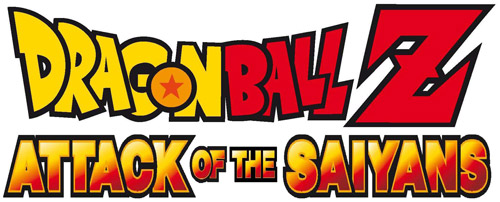
Quick Details:
| ASIN: | B002DY9KKM |
| Developer: | Monolith Soft |
| Publisher: | Namco-Bandai |
| Release Date: | 04 November 2009 |
| MSRP: | $29.99 |
| Platforms: | Nintendo DS |
|
|
|
Review of this game was made possible through a copy provided by Namco-Bandai. If you are interested in contributing to the site, please visit our “Donate” page or contact us directly.
Review By: Mike LaBrie (VegettoEX)
So how about that there video game…?
How We Gamed:
With my original DS’ screens beat up from too much loving and a DSi not yet in the cards, the game was played in its entirety on the currently-standard DS Lite.
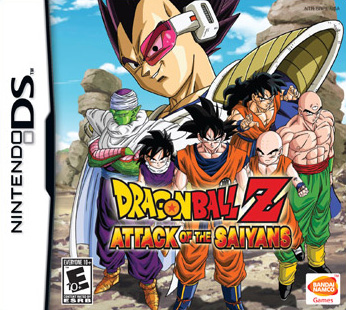
As with any North American release of a Dragon Ball game, the first thing I do is hop over into the options to switch the language track to Japanese. All prior DS releases (Supersonic Warriors 2, Harukanaru Densetsu, and Dragon Ball Origins) have been English-dubbed-only. Dual-language selections have been limited in the handheld space to the Shin Budokai games on the PSP. Unlike their console brethren, however, the handheld games typically have little more than standard grunts and signature-attack yells which can be more easily ignored by the player. Whether we should chalk this up to laziness or a conscious decision on their part, Namco-Bandai has opted for a Japanese-only voice track in Attack of the Saiyans (despite the Chris Sabat-run OkraTron 5000 credits present upon starting the game). There is no selectable voice language track available. This is certainly how we prefer to play the games, so it works out quite well for us.
Amazingly enough, despite the game being out for so long in Japan with no American announcement in sight, I actually did not import the game ahead of time. It never completely fell off my radar, but I also did not make a conscious effort to go out of my way to learn more about the game. Our buddy Herms was over in Japan when the game came out and let us in on pretty much all secrets the game had to share, but beyond some quick skimming of those posts, all I knew was that the game was a standard, turn-based, Japanese RPG, and it covered the earliest parts of the “Z” storyline.
I jumped into the game after the completion of Revenge of King Piccolo and Raging Blast, respectively. It was a nice progression: the first game was incredibly short and something new for the franchise, the second required a little more dedication to unlock everything yet remained stuck in the standard fighting game cycle, and here we are with an RPG that would require even more of a time sink, but could be taken on-the-go.
The majority of time spent with the game was either at home on the couch, on the train to and from work, and a little bit here and there on lunch breaks. It worked perfectly well in all of these situations. With unlimited time at home, one can charge through various missions and go on longer adventures. With shorter commuting and break time frames, a little extra level grinding or going back to pick up items that could not be reached before were perfect, short time-sinks.
From start to main story completion, 25 hours were put into the game. Some of that included the aforementioned extra grinding sessions during commutes and lunch, so sway that hourly total a little back and forth for a good approximation of how much time you may put into it. With the exception of the secret boss character, the only “extra stuff” available will be standard fare for regular RPG players — grind your characters up to even higher levels, go back and grab even more items you may have missed along the way, and maybe take down that extra boss character.
PRESENTATION:
Attack of the Saiyans feels perfectly at home on the Nintendo DS. Entirely presented with 2D sprite work, it feels like a 16-bit RPG in the Squaresoft and Enix heyday transported up to the original PlayStation with its extra bit of processing power. In-battle characters are detailed and move with a wide array of actions (as well as detailed facial expressions), yet the “map” or “walking” versions of the characters are tiny with limited animation.
Environments are depicted with jaw-dropping detail. From the tiny, dead bodies impaled on the spikes of the Divine Crossing, to Kami’s spaceship buried in the snow of the Yunzabit Highlands, to Mount Five Element… there will be many times you will want to stop playing to just stare in awe at the absurd level of care put into the environments. There were a couple instances where, actually due to too much detail present on the screen, I was unable to figure out which path to take — one of these instances was searching for a path through an overhang in Mount Paozu on the way to find Yamcha, and another finding an underpass to get to a save point after finding Gohan’s robot friend. A little bit of wandering around and testing pathways solves the problem, but it will occur from time to time.
While there are no animated cut-scenes, many full-screen drawings will take their place between storyline sequences. For the most part they are well drawn and bring the anime to the DS screen in a respectful way, though a small number of them do feel like the character designs are a little “off”. A single landscape explosion scene is recycled time and time again (for example, used both as Yamcha’s Saibaiman explosion as well as Vegeta’s “exploding after being hit by the Genki-Dama” growling smash). Occasionally, the screens will blank themselves down in what would appear to be another of these full-screen drawings, only to come back up to the exact same overworld/pixel-drawn characters. Were additional screens planned but never implemented? It can be confusing, but is a quirk of the game you will come to accept and ignore.
The overworld map is the one area of presentation that feels antiquated by comparison. Rather than any SNES “Mode 7” toss backs or flying a la the previous generation of console games such as Budokai 3, you travel to new areas by moving a flashing box from point to point on the map. There is no character representation to be seen, similar to the navigation of GameBoy Advance games such as the Legacy of Goku series. It is the only disconnect in the game’s presentation, which otherwise pushes the tech forward, even if ever-so-slightly.
Music runs the gamut from nothing more than acceptable to, shockingly, a few pieces of near-brilliance. The Divine Crossing music is incredibly haunting and moody, setting up the perfect feeling for an ominous adventure in this mystical place. Even the “(Great) Devil’s Toilet” music has its own tone and sneaky feeling to it. Voices are limited to general kiai and signature attack yells, but are performed by the original cast with gusto. Being a handheld game, the majority of your gaming time may be spent with the volume turned down, but the game deserves some headphone use due to its music at least part of the way through.
Story wise, Attack of the Saiyans runs from just before the 23rd Tenka’ichi Budōkai up through the end of Saiyan arc; you will begin with some pre-tournament training among Kame-Sen’nin’s pupils, and conclude with the battle against Vegeta. This sounds fantastic in theory, especially since so few games cover this era of the Dragon Ball storyline (either starting with Raditz, or never making it past Red Ribbon). The ultimate irony of the game’s storyline content, though, comes with the fact that it was renamed under the Kai moniker in Japan. It can perhaps best be described as “DB/Z Filler: The Video Game”. Familiar filler material, such as putting out the flames to save Chi-Chi’s wedding dress, Goku’s encounter with Princess Snake, and his accidental fall down to Hell are all present. How about that time that Goku fought against Raditz’s spirit in Enma’s forest alongside Bubbles and Gregory? And then you spread (what is heavily alluded to as) feces over a bunch of tree trunks? Or that time Lunch went missing trying to find a flower to heal a boy’s sickness? Maybe you remember when Goku came back before Vegeta arrived to help his friends gather the Dragon Balls with which to wish him back, only to have them stolen by Pilaf?
No? You don’t remember these? Be prepared for a new fetch-quest every time you think you are about to hit another landmark in the story’s progression; I was fully expecting Vegeta to send me to go find a sheep or something before allowing me to battle him. Most of them are at least interesting enough in their sheer absurdity, but there will be several instances where you simply want to move on with the actual storyline of the series. This turns an otherwise 10-hour game into a 20-hour game, acting as the padding (and excuse) to grind up your characters. They will all fall into two categories — you are either on a fetch-quest (go find an arbitrary item [with no game play benefits] before continuing the story), or rescue another character (such as Chiaotzu, who is not playable, anyway). The two are essentially the same, but presented in slightly different ways. This does allow you to visit plenty of fan-favorite locations that would otherwise just be name-dropped. Cameos are aplenty and extend to what would otherwise be faceless minions; baby Piccolo lookalikes litter the demonic realms you visit, while you will also run into Mîra-kun lookalikes. Were the adventures a little less absurd and the landscapes not so painstakingly detailed, I would have a much bigger problem with them. They are still a “fault” to be found with the game, but their light-hearted nature makes it difficult to truly detest them.
This, of course, means that you will get much more out of the game if you are a relatively “hardcore” fan of the series. That term feels like it gets tossed around all over the place (and recklessly so) these days, but it is true. Having no familiarity with the series and its story at all, new players will feel lost and have zero appreciation for the characters, never mind these pointless side adventures (and nor should they have that appreciation). On the other hand, those with over a decade of fandom seeping through their veins will likely eat up each opportunity to stray from the beaten path and explore.
Those with a high familiarity level with gaming in general will love all of the little touches in the localization. In particular, a ghost in the top level of Uranai Baba’s building will give you free money and say “It’s a secret to everybody.” Many of the non-dub-specific phrases and aspects are translated faithfully, and only in line with previous reversionings when one exists (attack names such as “Solar Flare”, proper nouns and names such as “Flying Nimbus”).
Gameplay:
Attack of the Saiyans plays very much like any traditional Japanese RPG that you may be familiar with. Fans of the Final Fantasy, Dragon Quest, and even Pokémon games will feel right at home. The game is presented in the standard overhead 2D sprite world that players maneuver, all the while being ambushed by random enemy encounters. Depending on the point in the story, players will have anywhere between one and three characters in-battle at any given time, with (again, depending on the point in the story) another three characters in reserve to hop in at will (Goku, Gohan, Piccolo, Tenshinhan, Yamcha, Kuririn). During the turn-based battles, players can choose their actions ranging from attack to defend to item usage and more. Characters have separate health and ki meters; when their health reaches zero the character is defeated, but when their ki reaches zero they simply can no longer use special attacks until it is refilled. As your characters both inflict and take damage, their “Rage” meter will fill up; at its max, and assuming you have enough ki points, you can have your character unleash a “Super” special attack such as Goku’s Genki-Dama or Gohan summoning Haiya Dragon to heal the entire party. At the completion of every successful battle, experience and ability points are awarded to each character, including those not actually participating in the battle (though to a lesser extent with this group). Characters “level up” by reaching the necessary amount of experience points, while ability points can be traded in for upgraded stats and techniques.
Players will want to pay attention to those ability points. I widely ignored them for approximately five hours of game play before even bothering to explore what they actually did. From the “Skills” sub-menu, as mentioned, these points can be traded in for upgraded stats and techniques. Upgrading a character’s Kamehameha will result in it costing more ki points to use, but its potential damage will also be significantly increased. Certain characters also have very specific stat boosts, such as Yamcha allowing for additional speed increases, and Goku focusing on “Dodge” and “Chain” increases. The game becomes much easier when you upgrade accordingly, giving your characters a better chance of dodging attacks, landing chain combos, and more.
That is one of the biggest issues with the game: its incredibly forgiving difficulty level. Just as Revenge of King Piccolo let you immediately start where you died with no major penalty, Attack of the Saiyans does this in its own way. When a character levels up, their health and ki meters are immediately filled to their max. Any save point will refill your entire party back to complete health, as well. With save points often spread at the beginning, mid-point, and near-end of each segment of the world you visit, you never truly feel desperate or uneasy about plugging onward; you will either level-up and heal along the way, or simply make it to that next save point to heal everyone at once. As a standard RPG staple, you will find yourself hovering around a save point doing a little extra level grinding before fully moving on, knowing that you can hit those extra hundred experience points, save, heal, and be on your way.
Perhaps another contributor to the game’s ease is the way in which you will undoubtedly find yourself battling enemies. Especially early on in the game (where you do not yet have an optional item that regrows your ki meter as you walk), there is a good chance you will use your standard physical attacks on all minor enemies, and spam the area “boss” character with nothing but your strongest ki attacks. This makes for incredibly effective, and equally incredibly boring, battles. To mix things up, you may occasionally use the mostly-hidden “S-Combo” attacks, where characters with their full “Rage” meters can execute combination attacks with each other to deal further damage. These “S-Combos” are a fun way to pass the time in-battle, and will be unlocked as you progress through the game and find hidden notes that instruct you on how to initiate them.
At the beginning of the game, you are given two “Capsule” slots. Items with special attributes can be inserted into these slots to give you bonuses such as poison protection, ki refills, bonus experience points, and more. As you progress through the game, you will unlock extra “Capsule” slots to further boost your attributes. There is a good deal of balance to the system, though; an item in the primary slot will always have its full effect, but items on reserve may only work at 50% effectiveness, or possibly not at all. Keeping your “Ninja Sandals” on to lower the chance of random enemy encounters may be your primary goal, but keeping the Gas Mask inserted into a reserve slot means you will still take 50% poison damage meandering across the contaminated walkways.
In the non-battle portion of the game, your character will have a ki meter that can be used to power attacks that destroy items like rocks that are obstructing paths. This meter is not tied to the in-battle ki meters per individual character, and refills automatically as you walk. It can be leveled up three times over the course of the game, allowing you to blast your way through items that flash orange, white, and black (each with different necessary strength levels). It seems strange that this meter is so irrelevant to the characters, themselves, and only useful in this one particular way.
Despite having at least two characters available at most points during the game, more often than not you will be playing as Goku — fairly expected for a DBZ game, of course. The others get their time to shine, but you are best placing emphasis on leveling up Goku more than anyone else. You know that your final battle will primarily be using Goku to fight against Vegeta, so it makes the most sense to place your emphasis on him. The supporting characters (namely Gohan and Kuririn) will be fine on their own without any additional grinding to be sufficient during these final battles.
Quite often, I yearned to be able to stop what I was doing and explore the Dragon World in Attack of the Saiyans. The game is very “mission”-structured and linear, as explicitly showcased by the available “Crystal” menu option which reminds you of your progress, providing very few opportunities to do that exploration. The game does a fantastic job of providing a sense of urgency to press onward with the current mission, which helps to offset the natural desire to peek around the corner to see what else is out there. The player receives just enough of a taste of the full world over the course of a few specific missions (all fetch quests) to satisfy that itch until the near-“end game” content where full exploration is possible.
In a nutshell, the game could sarcastically (but realistically) be renamed Press ‘A’: The Video Game. You could make this argument for any standard, Japanese-created, turn-based role-playing game, but it feels more excessive here than ever before. Between waiting for all of the characters to emote, say their dialogue (with excessive line-breaks when it all could have fit on one line), and everything else tossed at you… it becomes tiresome. The long stretches of no game play other than watching characters talk for five straight minutes is enough to test anyone’s patience. The “Active Guard” helps break up the battles a bit with the “X”, “Y”, and “B” buttons corresponding to each character, but that darn “A” button will wear down over the 20+ hours of game play.
The additional functionalities of the DS are not put to use in any significant way with Attack of the Saiyans. Rather than pressing the “A” button, players can tap a giant square on the lower screen to advance dialogue. Battles take up the entirety of the top screen, while the lower screen showcases action options with big, colorful buttons that otherwise could have been arranged into one screen. The microphone is not used. Thankfully, we are at a point in the life span of the DS that developers do not feel the need to use all of these extremities, and instead focus on streamlining the actual presentation and input methods to their best use. Everything works as it should, does so easily, and does so without confusing the player.
The Extra Stuff:
Attack of the Saiyans offers the same type of “extra” material as most role-playing games: better items, extra areas to explore… and that’s about it.
As opposed to a game like Pokémon where after “beating the game” (defeating the Elite Four) you still have an entire world to explore as an end-game with no set purpose, Attack of the Saiyans falls more in line with a Final Fantasy where “beating” the game does nothing more than showcase the ending credits followed by a trip back to the main menu. There is no “saving” the game after it has been completed, so you are in a perpetual mode of a near-beaten status if you make it that far.
This is where the game truly opens itself back up, though. You will be instructed to visit Mr. Popo after the death of Piccolo and Kami, you will visit Baba who can temporarily resurrect one of your fallen comrades for extra party members, and you will be able to track down the Dragon Balls to make a wish (yes, despite the wish just being made to bring Goku back to life; you will have to suspend your knowledge of the plot device rules). You can even capture one each of all the different enemies scattered across the entire world for bonus items by bringing them to Kami and Mr. Popo, giving it that extra “Gotta Catch ’em All!” push.
Dragon Balls can be found scattered across various locales that you have visited over the course of the game, which gives you another great opportunity to bash your way through the environmental hazards that you did not have the ki meter (or health points) to break through twenty hours earlier in the game, such as the treasure path off to the eastern side of Mouth Paozu. Of the available wishes (extra experience points, extra ability points…), the most interesting and game-opening option is for a new area to explore. This will grant you the ability to wander the full remains of East City, which was destroyed with the arrival of Vegeta and Nappa; even more items can be found among the wreckage. If you collect the Dragon Balls yet another time, you can wish to fight the “ultimate” opponent, which will open up a new portal, providing the route to do battle with the game’s secret boss.
Without fully spoiling it for you (but coming pretty close; oh, who am I kidding… the image is below), remember that this is a DBZ game released in 2009. There is one, sole character that has been whored out more than any other since the resurgence of new games post-Final Bout, and his relevance to the storylines in question has always been lacking. Also, he yells a lot.
Whenever you feel like it again, you can challenge Vegeta to the final battle, which gets more and more hilariously short as you have leveled-up in the meantime. It is not a difficult battle with a standard play through, never mind with some of the bonus items and experience in tow gained along the way.
Final Thoughts:
Attack of the Saiyans has a lot of great things going for it. The sprite work is fantastic in-battle and acceptable on the world map, the music ranges from simply “existing” to groove-along worthy, and the extra story elements are generally irreverent enough to put a smile on your face. The franchise has a deep history with card-based battles and game board maps, so while a “traditional” RPG dress-up would be overkill for many franchises, it feels fresh for DBZ. There is a good amount of gaming to keep you busy for your $30, especially if you choose to dip into the quasi-“end game” content.
At the end of the day, Attack of the Saiyans is a competent, traditional, turn-based, Japanese role-playing game that just drags on too much and too often. Whether or not that will be a detriment to your enjoyment is solely on you and your tolerance level. As the credits end with a silhouette of Freeza, there is a good chance we will see a sequel to the game in the relative-near-future. It would be great if they could speed everything up a little bit to trim the fat, which would potentially give us a pretty solid product, even with the DS-licensed-shovelware image it may have with the general gaming masses.
Despite being down on the game’s obvious faults, and despite the review being complete, I still find myself returning to the game (unlike Revenge of King Piccolo and especially Raging Blast) for a quick round of Dragon Ball collecting, random grinding, and area exploration. It works great in these short stints of game play, and there is clearly an underlying element that I cannot quite put my finger on that just oozes “fun”. There is a good basis here — let’s see them knock it out of the park next time.
Attack of the Saiyans was developed by Monolith Soft and published by Namco-Bandai, released in North America on 10 November 2009. MSRP $29.99. Standard story was completed in approximately 25 hours, which included more-than-standard, extra grinding sessions. Died twice (once during the final Vegeta battle). Post-completion, collected the Dragon Balls twice for “end-game” content expansion, explored East City, and gathered bonus items. Goku at level 76 by review publication.
Purchase This Item:
Attack of the Saiyans may be available at the following retailers:

